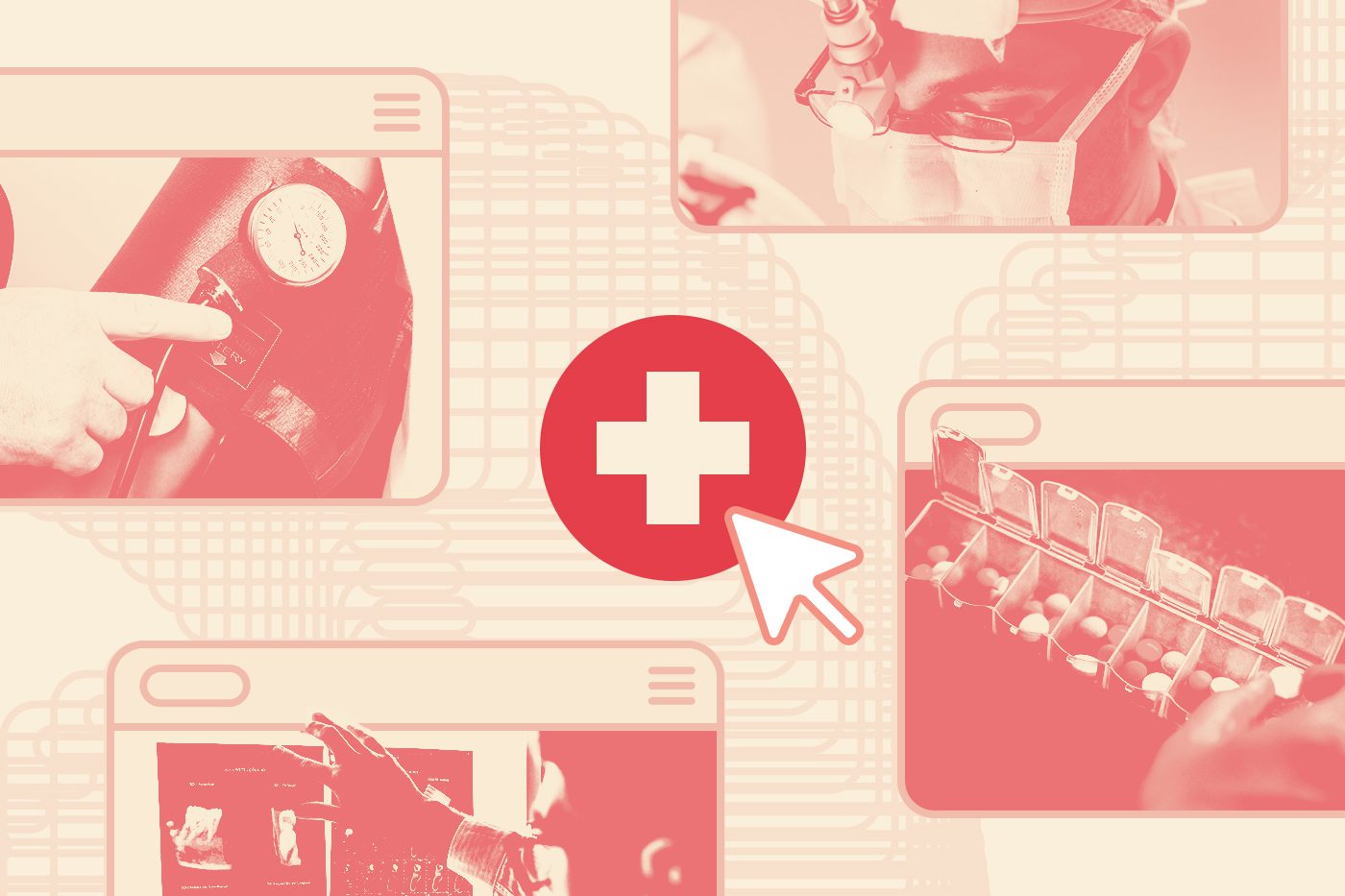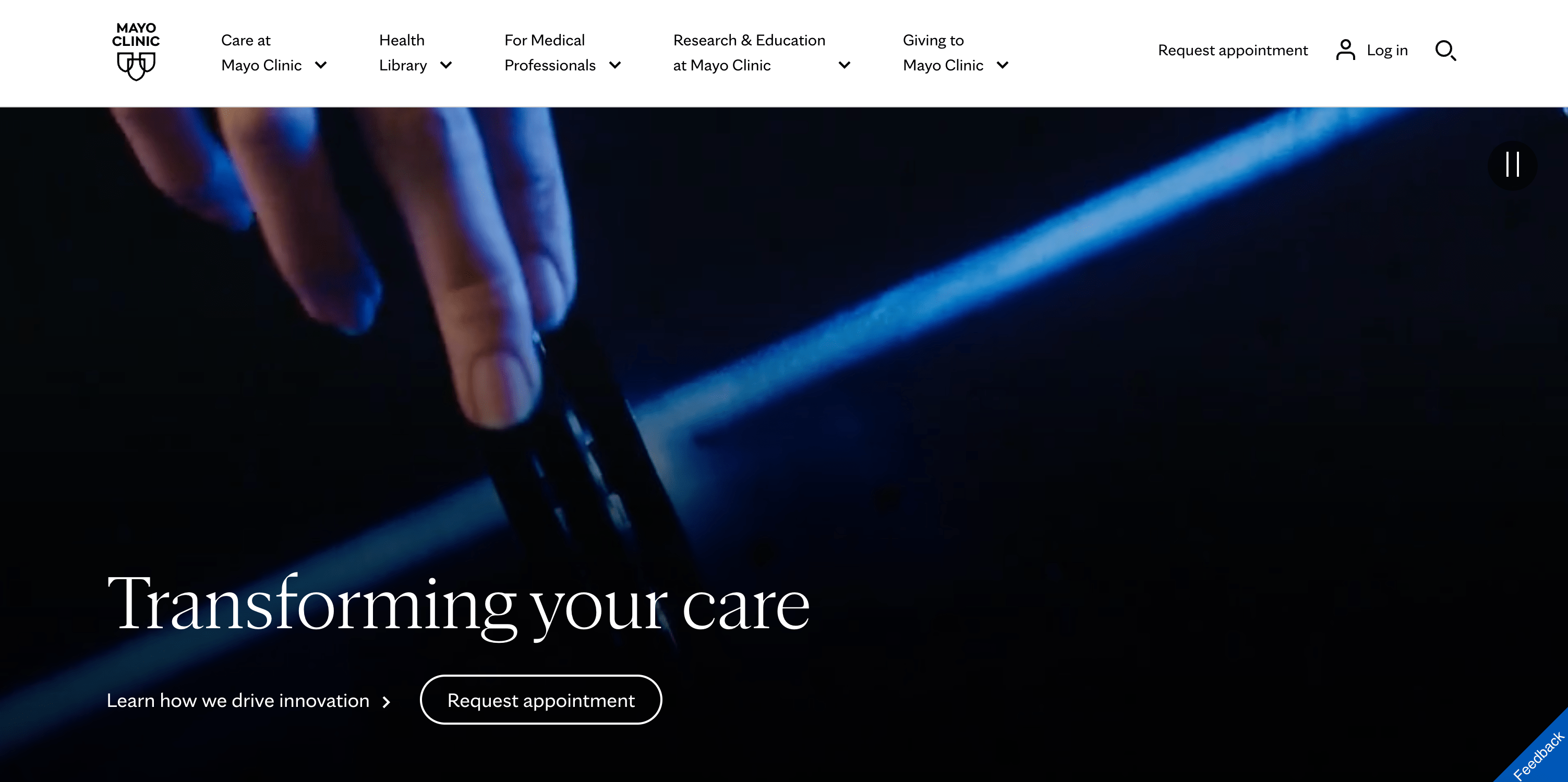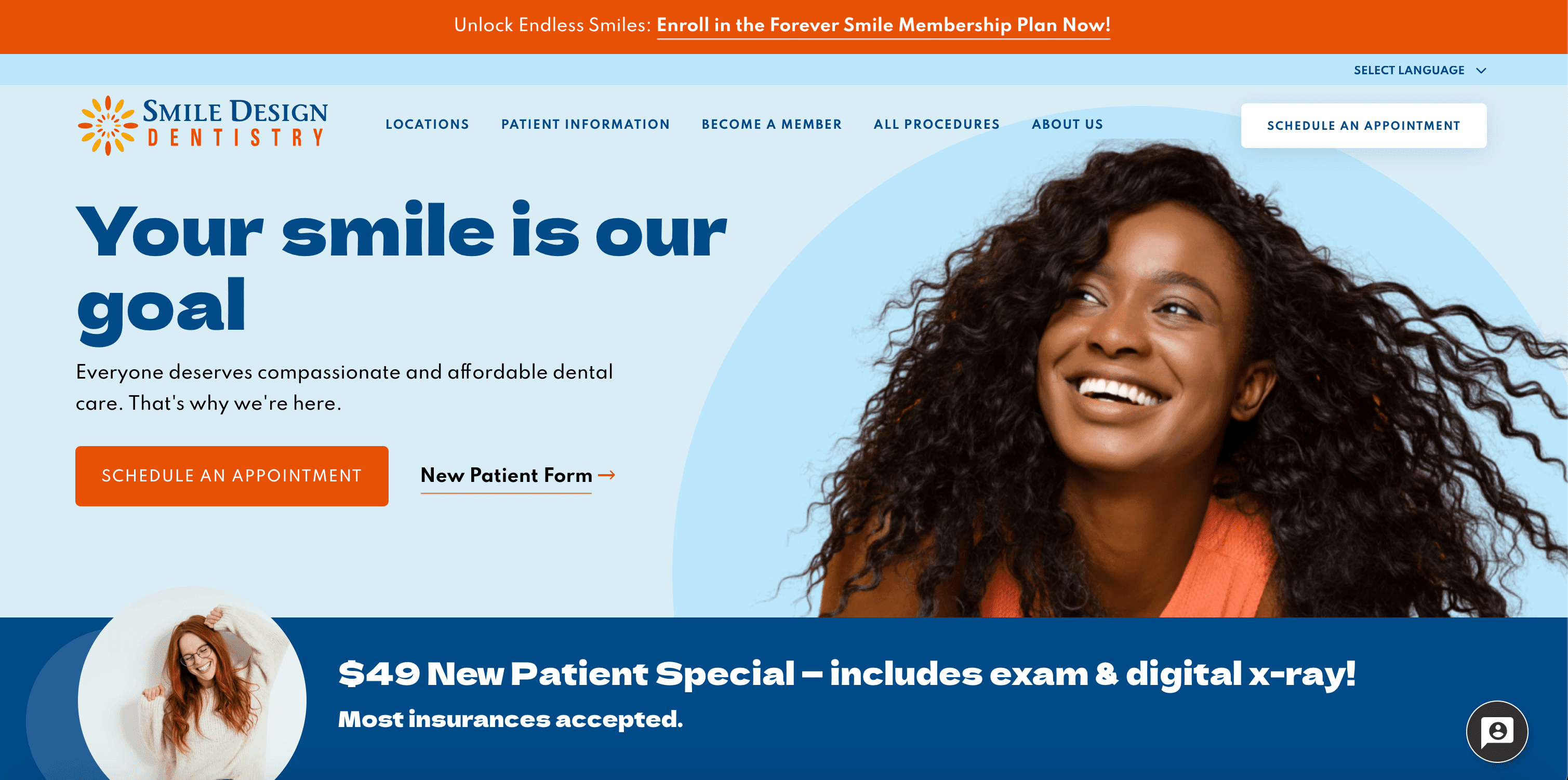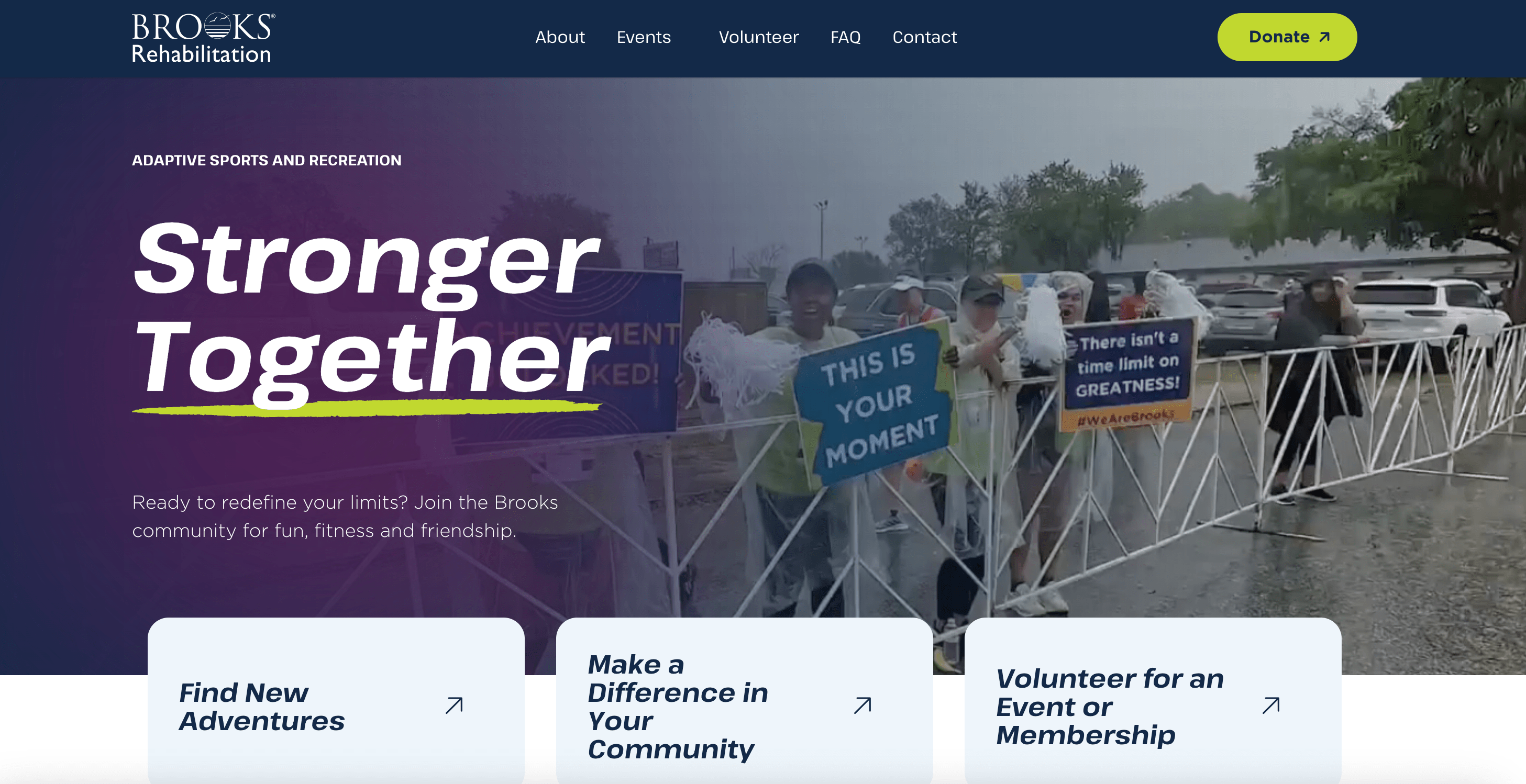Healthcare Website Design: 10 Inspiring Examples (+ Tips)
- 10 Healthcare Website Designs We Love
- 1. Mayo Clinic
- 2. Cleveland Clinic
- 3. Planned Parenthood
- 4. Smile Design
- 5. LED Technologies Inc.
- 6. Livongo
- 7. Brooks Adaptive Sports
- 8. Michigan Avenue Primary Care
- 9. Skincare by Ava MD
- 10. Maven Clinic
- Tips for designing a great healthcare website
- Why healthcare website design matters
- Discover how Big Sea can improve your healthcare website design
Whether you’re looking for a deep dish delivery or a new doctor, what do we all do first these days? Whip out the smartphone.
According to a CDC report, almost 59% of US adults used the internet to look up health or medical information in the second half of 2022, and almost 42% used it to directly communicate with a doctor in the same time frame.
In coming years, the number of patients using online research for healthcare needs and online healthcare management will only continue to grow. Yet designing a beautiful, informative, user-friendly, SEO-driven, and HIPPA-compliant website is no mean feat.
Let’s take a look at some of our favorite healthcare website designs to see what makes them stand out.

10 Healthcare Website Designs We Love
1. Mayo Clinic
We love Mayo Clinic’s clean, bold design and user-friendly navigation. Check out the fascinating, sometimes abstract videos playing behind a few simple pieces of text that lay out both the Mayo Clinic’s mission and a few key calls to action in the hero section.
As a well-known and respected research institution and world-class care center, the Mayo Clinic highlights both of these aspects of their work: “Learn how we drive innovation” takes users to another page that highlights research breakthroughs, while “Request Appointment” allows users seeking care to find the right page immediately.
Behind the scenes, Mayo’s outstanding SEO strategy captures traffic from internet searchers looking for trustworthy healthcare insights. The website’s use of structured data, together with its approach to information architecture, allows the website to serve Google an experience that is also great for searchers, so that no matter how you arrive at Mayo’s website, you find the information you need.
Overall, the Mayo Clinic site marries clean, user-friendly design with a clear emphasis on their strengths as a highly trusted source of medical information, research, and care.

2. Cleveland Clinic
As an example of a patient-centered web design, the Cleveland Clinic does an excellent job of anticipating the most relevant information to present to current and potential patients.
When you land on the site, just beneath an inviting, high-quality banner image, you see three graphic options that allow users to find a doctor, to view directions & locations, or to schedule an appointment. Again, much like Mayo Clinic, a user-centric navigation experience is also bolstered by a strong organic search strategy that brings users to many deeper pages that aren’t immediately visible in the menu.
Overall, the Cleveland Clinic website is effective because it is patient-centered, emphasizes staff expertise and focuses on innovation and research.
3. Planned Parenthood
Unlike many healthcare sites, Planned Parenthood doesn’t overwhelm users with information at first glance. Instead, the site does an incredible job emphasizing their trustworthiness as a healthcare provider and a source of information on sexual and reproductive health with a few key call outs. With that, we see a menu that puts educational information at the very front of its options, as “Learn” is the first tab you can choose from.
The bold background colors with white text call users attention to important information about booking appointments, learning how to access safe and legal family planning, and accessing 24/7 chat with sexual health.
The website communicates to users that they can trust the organization to provide trustworthy information and in-person services and care.
4. Smile Design
With clear, bold text and color choices, Smile Design Dentistry invites users to make an appointment, fill out a new patient form, and learn about ongoing specials. This website achieves that patient focus we have seen on other sites in part through beautiful, high-quality images of big smiles to engage visitors and remind them of one of the reasons high-quality dental care matters.
Under the fold, the site emphasizes the multiple services and benefits of Smile Design through a mix of easy-to-read text and simple graphics. By featuring a positive review in large text, the site encourages new patients to learn more about Smile Design’s offerings.

5. LED Technologies Inc.
LED Technologies Inc. demonstrates how a site can act as both an online storefront and educational hub. Light therapy products and their uses are still unfamiliar to many, so LED Technologies foregrounds potential uses in skincare, pain relief, and in-home sanitation with beautiful images and simple, easy-to-read text in the hero section.
As users scroll through the cleanly designed site, they will find more opportunities to learn about the science behind light therapy and the products provided by LED Technologies.
Products, with star reviews highly visible, appear at the bottom of the homepage. This allows website visitors time to learn about light therapy technologies before seeing the storefront. This is an example of an effective flow for educating website visitors about new healthcare products.
6. Livongo
Livongo exists to help people effectively use their healthcare benefits to access smart devices and health coaching at no additional cost. Therefore, the Livongo website quickly communicates to visitors their role and the benefits users can gain from working with Livongo. Unlike some other sites on this list, Livongo’s user experience is structured around exploring the treatment options they offer.
The website effectively uses a pop of green to draw attention to the fact that Livongo won’t cost users any money. In addition, the site mixes bold text, simple icons, and plenty of whitespace to guide users through the process of gaining access to Livongo benefits.
7. Brooks Adaptive Sports
Brooks Adaptive Sports immediately inspires website visitors with the celebratory, confetti filled banner video of a race finish-line. This page was designed not only to put patients and their caregivers at the center of the website’s story, but also to celebrate them, which is precisely the experience you have when you land on the homepage.
The three options that abut the hero section invite participation in the organization through events and volunteer opportunities. These design choices mean that inspired visitors can immediately find out how to deepen their interaction with the org. Right under the fold, a participant testimonial builds further confidence in the meaningful work done by Brooks Adaptive Sports.

8. Michigan Avenue Primary Care
With its calming blue background and simple navigation, Michigan Avenue Primary Care is an effective service-centered website design. Whereas most of the examples in this list are patient-centered, this style allows users to navigate the site by choosing what kind of care they’re looking for as well as other options like paying a bill. That’s further evidenced in other choices like highlighting hours, appointment booking, and COVID vaccine information.
Under the fold, users are invited to learn more about the practice. With ample white space and the continued use of a calming blue color scheme, patients are invited to learn about specializations and more.
9. Skincare by Ava MD
With its teal accents, high-quality facility photos, and well-known endorsements featured in the hero section of the site, Ava MD immediately establishes itself as a premium destination for cosmetic dermatology.
Under the fold, bold color choices and images focusing on Ava MD services dominate. The easy-to-use website invites visitors to learn more about each service.
10. Maven Clinic
The first thing you might notice about the Maven Clinic website is the hero image featuring a baby in focus with other family members in the background, all surrounded by a calming soft green color.
Maven Clinic uses a limited set of search options to guide users’ understanding of their services with their “I’d like to find out about” search. This choice allows website visitors to immediately intuit the Maven Clinic’s potential role in individual and group healthcare options.
As users scroll, Maven Clinic emphasizes their specializations in fertility care and telehealth with clear text and images.
Tips for designing a great healthcare website
As we saw in these examples, there are really two main strategies for approaching a healthcare website: patient-centered and service-centered. In the former, the navigation emphasizes the patient’s experience and carries them through choices they might make as a patient. In the latter, the website is structured around choosing between the various services provided. Your choice in strategy should reflect who you are as an organization.
When it comes to web design for healthcare, ensuring your content is trustworthy and evidence-based is key. Your website users will trust that your site contains up-to-date and accurate health information, and meeting that need for high-quality information is one of the key ways your website can serve patients and potential patients.
In addition to high quality content, effective healthcare websites have clean, simple, and intuitive designs that make it easy for users to navigate and find the information they need. Always make sure your website is mobile-friendly and ADA compliant so that all users can access your site seamlessly.
Use high quality images of staff, facilities, and more to make the website visually appealing and easy to navigate. If you’re not sure how to begin making your healthcare website both aesthetically pleasing and highly functional, check out our guide on website redesign for some additional tips and ideas.
Finally, be sure to include features like online appointment scheduling, useful search functionality, and, when appropriate, interactive or specialized content that showcases your areas of strength. This could include patient testimonials via text or video, explainer articles or vlogs by staff members, video facility tours, informative blogs, and more.
By following these tips, you can create a healthcare website that is informative, user-friendly, and builds trust with both current and potential patients.
Why healthcare website design matters
With the rise of online healthcare research and communications, healthcare websites are now the initial touchpoint for patients seeking providers, services, and facilities. This makes healthcare marketing and website design crucial for fostering patient engagement, satisfaction, and potentially, even health outcomes.
Strategic website design also drives business, especially if you employ SEO expertise to help you make the most of your content.
Discover how Big Sea can improve your healthcare website design
At Big Sea, we thrive when we partner with organizations that make a difference in people’s lives, which is why we love helping health & wellness clients create incredible websites and effective marketing strategies. Contact us today to get started.
